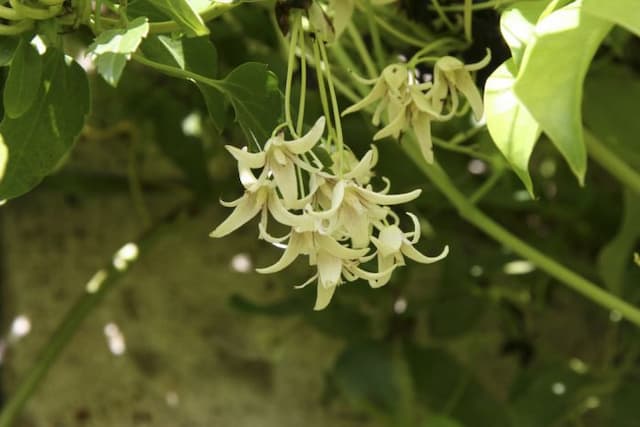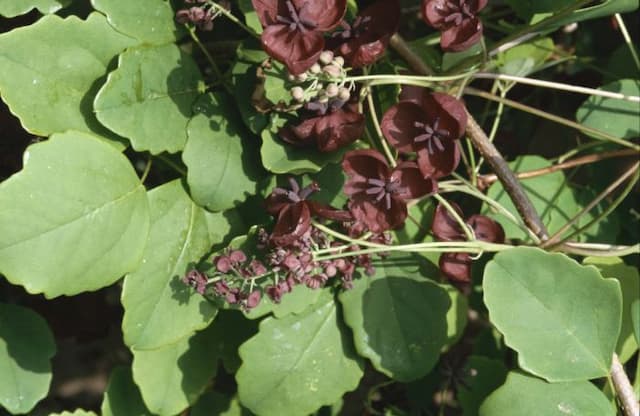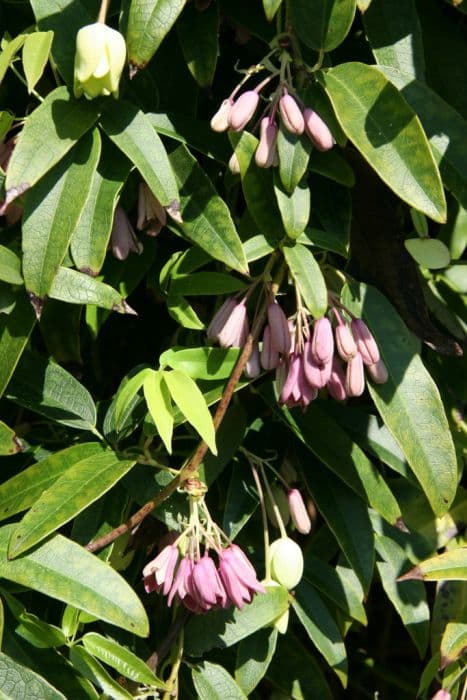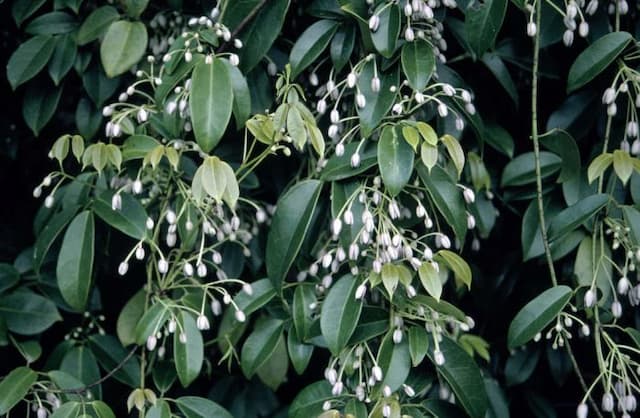Akebia longeracemosa

ABOUT
Akebia longeracemosa, commonly known as the chocolate vine, is a climbing plant that is valued for its ornamental features. The plant has compound leaves that consist of five individual leaflets, which emanate from a central point like the fingers on a hand. These leaves are typically bright green, which can add a lush appearance to any garden space. What makes the chocolate vine particularly attractive are its flowers. They bloom in spring, presenting in beautiful racemes, which are clusters that give the plant a somewhat elongated appearance. Each flower is delicate and intricate, colored in subtle shades of purple, sometimes described as having a chocolatey hue – hence the plant's common name. These flowers are not only visually appealing but also exude a gentle fragrance that can be quite enchanting. Following the flowering period, the chocolate vine may produce fruits. These are sausage-shaped pods that mature in the fall and can add an additional point of interest to the plant. These pods, when opened, reveal a white pulp along with black seeds, providing a striking contrast against the matured outer skin of the fruit. The stems of the chocolate vine are slender and have a twining nature, which allows the plant to wrap itself around supports, cling to trellises, or even scale over other plants or structures. This characteristic makes it a versatile choice for gardeners looking to add vertical elements or green coverings in their landscape design. Overall, the chocolate vine is appreciated for its graceful foliage, beautiful and aromatic flowers, and interesting fruit pods, all of which contribute to its popularity as a garden plant. Its twining habit and ornamental qualities make it a favorite among those looking to create a charming garden retreat or a naturalized area within their outdoor spaces.
About this plant
 Names
NamesFamily
Lardizabalaceae
Synonyms
Chocolate Vine, Five-Leaf Akebia
Common names
Akebia quinata var. longiracemosa
 Toxicity
ToxicityTo humans
Akebia longeracemosa, commonly known as chocolate vine, is not widely regarded as a toxic plant to humans. However, there is limited information available on its potential toxic effects if ingested. As with many plants, it is advised to exercise caution and avoid ingesting parts of the plant unless it is deemed safe by qualified experts. Without definitive evidence of toxicity for humans, no specific symptoms of poisoning can be provided.
To pets
The chocolate vine, while not commonly listed as a toxic plant, may still pose some risk to pets if ingested due to the potential for plants to have varying effects on different species. As precise toxicity information specific to pets for Akebia longeracemosa is lacking, it is advisable to prevent pets from ingesting the plant as a precautionary measure. Without concrete data, it is challenging to provide a list of symptoms that might arise from ingestion by pets. If you suspect your pet has ingested any part of the plant and is showing unusual symptoms, it is recommended to consult with a veterinarian.
 Characteristics
CharacteristicsLife cycle
Perennials
Foliage type
Deciduous
Color of leaves
Green
Flower color
Purple
Height
20 feet (6 meters)
Spread
9 feet (2.7 meters)
Plant type
Climber
Hardiness zones
4
Native area
Asia
Benefits
 General Benefits
General Benefits- Ornamental value: Akebia longeracemosa, known as the Chocolate Vine, has attractive foliage and unique, deep purple flowers that provide aesthetic appeal when used in landscaping and garden design.
- Growth habit: It's a fast-growing vine that can quickly cover structures such as trellises, fences, and arbors, providing shade and privacy.
- Drought tolerance: Once established, the Chocolate Vine is relatively drought-tolerant, requiring minimal watering in suitable climates, which can reduce the need for irrigation.
- Erosion control: Its vigorous growth habit and ability to spread can help stabilize soil in areas prone to erosion.
- Edible parts: Parts of the Chocolate Vine, such as the fruit, are edible and can be used in cooking or eaten raw, providing an alternative food source for humans.
- Wildlife attraction: The plant can attract pollinators like bees and butterflies to the garden, which is beneficial for plant pollination and overall biodiversity.
- Screening: Because of its dense foliage, it can be used as a natural screen to hide unsightly views or as a living wall for privacy.
 Medical Properties
Medical PropertiesThis plant is not used for medical purposes.
 Air-purifying Qualities
Air-purifying QualitiesThis plant is not specifically known for air purifying qualities.
 Other Uses
Other Uses- The vine of the Akebia quinata can be woven into baskets or other craft items, utilizing its flexible and durable stems.
- In some regions, the young leaves of the Akebia quinata are edible and can be used as a wrap for sushi or other food items.
- The plant may serve as a natural shade cover when grown on pergolas or trellises, providing a cooling environment during hot summers.
- Akebia quinata's aggressive growth habit makes it suitable for covering unsightly structures like fences or walls, enhancing aesthetic appeal.
- Fruit of the Akebia quinata, when ripe, can be eaten and its pulp is sometimes used as a sweetener or dessert ingredient.
- The hollow stems of Akebia quinata can be used in floral arrangements or as natural conduits for small scale irrigation in gardens.
- Due to its interesting fruit shape and texture, Akebia quinata can be grown for ornamental interest in a garden setting.
- The dried seed pods of Akebia quinata are sometimes used in dried flower arrangements or as a unique element in potpourri mixes.
- Its rapid growth can provide quick greening and soil stabilization on slopes or areas prone to erosion.
- In certain culinary practices, the seeds of Akebia quinata are roasted and ground as a coffee substitute or additive.
Interesting Facts
 Feng Shui
Feng ShuiThe Chocolate Vine is not used in Feng Shui practice.
 Zodiac Sign Compitability
Zodiac Sign CompitabilityThe Chocolate Vine is not used in astrology practice.
 Plant Symbolism
Plant Symbolism- Mystery: Akebia quinata, commonly known as Chocolate Vine due to its purple-brown flowers and sweet scent, often symbolizes mystery because of its secretive growth habit, often weaving through other plants.
- Romance: The plant's fragrant and attractive flowers can be indicative of romance or sensual pleasures, resonating with its common name and the richness of its chocolate-like color.
- Connection: Akebia's ability to intertwine and connect with other plants in its environment can represent the human desire for connection and relationships.
- Resilience: Given its robust and vigorous growth habit, the plant can also symbolize resilience and the ability to thrive in a variety of conditions.
 Water
WaterChocolate vine, commonly known as Akebia quinata, should be watered deeply once a week, allowing the soil to dry out slightly between waterings. In hot, dry periods, increase watering frequency to every few days. Ensure that the plant receives roughly 1 to 1.5 gallons of water each time, depending on the size of the plant and environmental conditions. Overwatering can lead to root rot, so it's essential to check the soil moisture before each watering.
 Light
LightChocolate vine prefers a spot with full sun to partial shade. The best location would provide morning sunlight and afternoon shade, especially in hotter climates, to prevent leaf scorch. In cooler climates, a position that receives sunlight most of the day is ideal to promote flowering and fruiting.
 Temperature
TemperatureChocolate vine thrives in temperatures between 60°F and 80°F. It can tolerate a minimum temperature down to around 0°F, making it suitable for USDA zones 4 through 8. Extreme heat above 90°F for prolonged periods can stress the plant, so provide some afternoon shade in hotter regions.
 Pruning
PruningPrune chocolate vine in late winter or early spring to maintain its shape and encourage new growth. Pruning annually promotes flowering and prevents the vine from becoming too invasive. Remove any dead or damaged stems and cut back to control the size and spread of the plant. Pruning just after the blooming season can also help maintain a desired form and size.
 Cleaning
CleaningAs needed
 Soil
SoilChocolate Vine prefers well-draining soil rich in organic matter with a pH range of 5.5 to 7.5. A mix of garden soil, compost, peat moss, and perlite can create an ideal environment for this plant.
 Repotting
RepottingChocolate Vine generally does not require frequent repotting and can be repotted every 2 to 3 years, or when it outgrows its current container.
 Humidity & Misting
Humidity & MistingChocolate Vine thrives in moderate to high humidity levels, but it is adaptable and can tolerate lower humidity without significant problems.
 Suitable locations
Suitable locationsIndoor
Provide bright, indirect light, and ensure a trellis for climbing.
Outdoor
Plant in dappled shade or morning sun with a trellis for support.
Hardiness zone
4-9 USDA
 Life cycle
Life cycleThe life cycle of Akebia longeracemosa, commonly known as the Chocolate Vine, begins with seed germination, which occurs in warm, moist soil conditions typically in the spring. Once germinated, the seedling phase involves establishing roots and producing the first set of true leaves. As the Chocolate Vine enters the vegetative stage, it grows rapidly, developing a climbing or trailing habit with compound leaves and woody stems. Upon reaching maturity, which can take a few years, it enters the flowering stage, producing clusters of fragrant, purplish-brown flowers that are often pollinated by bees and other insects. After pollination, the plant produces elongated, sausage-shaped fruits that mature and eventually split open to release numerous black seeds. The Chocolate Vine is a perennial plant and will go through a period of dormancy in the winter, particularly in cooler climates, after which it resumes growth in the spring to repeat the cycle.
 Propogation
PropogationPropogation time
Spring to summer
The most popular method of propagating the Chocolate Vine, or Akebia longeracemosa, is through softwood cuttings. This technique is usually carried out in the late spring or early summer when the plant's new growth is just beginning to harden but is still flexible. Cuttings should be about 6 to 8 inches long (15 to 20 centimeters) with several leaves, and the lower end should be cut just below a leaf node. The cut end can be treated with rooting hormone to encourage root development and then planted in a well-draining potting mix. The cutting should be kept in a warm place with indirect sunlight and maintained consistently moist by covering with a plastic bag to retain humidity until roots have established, which typically takes a few weeks. Once rooted, the cutting can be transplanted outdoors to a permanent location in the garden.




